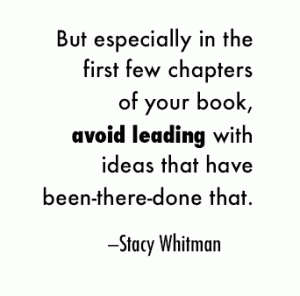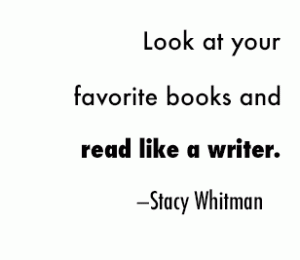In this series, Tu Books Publisher Stacy Whitman shares advice for aspiring authors, especially those considering submitting to our New Visions Award.
Last week on the blog, I talked about the importance of following submission guidelines and basic manuscript format. This week, I wanted to go into more detail about why a reader might stop reading if they’re not hooked right away. Here are some comments I’ve heard our readers make about manuscripts that didn’t hook them:
- Story does not captivate in first few chapters
- Boring
- Writing not strong, or not strong enough to hold a young reader’s (or teen’s) interest
- Parts of the writing are very strange (not in a good way)
- Sounded too artificial
- Reminds me too much of something that’s really popular
- Too Tolkienesque or reliant upon Western European fantasy tropes
- Concept cliche
How do you get your writing to have that “zing” that captivates from the very beginning? This is a little tougher than just following the directions—this is much more personal to each reader and each writer.
Is your writing boring readers?
There are a couple different issues in the list above. Some readers lost interest simply because they were bored. If you find yourself telling readers of your book, “Don’t worry! It gets really good in chapter five!” consider whether you’re starting your book at the right moment in time. The phrase “late in, early out” is one to remember—perhaps you don’t need all the information that leads to the “really good” part. Or perhaps you need to revise to make that information more interesting and faster paced.
I don’t recommend simply dumping this information into a prologue. Many young readers skip prologues entirely, and many more readers will lose interest if your prologue is long and boring—it’s the same principle as saying “just wait till chapter five!”
If the information in your first few chapters are crucial, yet readers are getting bored by it, consider spooling that information out little by little over the course of the book. You need to find the balance between giving enough information for the reader to be intrigued and wanting to know more, without overburdening the reader with so much information that they become overwhelmed or bored.
 For example, take the first few pages of Laini Taylor’s Daughter of Smoke and Bone. On page 1, Taylor sets up the scene: it’s an ordinary day in Prague (interesting point number one: how many books are set in Prague?) and Karou is walking down the street toward school, minding her own business. It’s an active scene—something is happening—but it’s more about Karou’s internal mundane thoughts. However, it doesn’t stay mundane for long. By page 2, she’s been attacked.
For example, take the first few pages of Laini Taylor’s Daughter of Smoke and Bone. On page 1, Taylor sets up the scene: it’s an ordinary day in Prague (interesting point number one: how many books are set in Prague?) and Karou is walking down the street toward school, minding her own business. It’s an active scene—something is happening—but it’s more about Karou’s internal mundane thoughts. However, it doesn’t stay mundane for long. By page 2, she’s been attacked.
But it’s not your average “you have to have an action scene in the first scene!” attack. The author plays with expectations, intriguing the reader and making you want to know what happens next. We get some ex-boyfriend banter (also against expectations) and the promise of interesting, embarrassing things to come by the end of the chapter.
It helps that the book is well written. But it’s more than good prose that hooks the reader here—she spools out just enough to let you know that this is a unique book, and that you want to know more. The next two chapters do the same thing, and bit by bit, the reader comes to know Karou’s intriguing magical background.
What she doesn’t do is infodump in a prologue or the first few chapters about Karou’s history, the history of the world, and the history of the strange beings who raised her. Save those details for when they matter.
Look at your favorite books and read like a writer. For hooking a reader, look in particular at excellent examples of the first five pages of a wide variety of books. There are many ways to effectively open a book, and you need to find the way that works for your story. Reading other books like a writer will help you to zoom in on ways to perfect your craft.
 Another great resource for writers trying to figure out how to hook readers is editor Cheryl Klein’s essay “The Rules of Engagement” in her book Second Sight. It’s no longer available online (and I don’t believe the book is in e-book form), but it’s worth the price of the book for her discussion of various ways to hook readers via character, insight, action, and other methods. (Bonus: you also then get access to all her other thoughts on writing and revision.)
Another great resource for writers trying to figure out how to hook readers is editor Cheryl Klein’s essay “The Rules of Engagement” in her book Second Sight. It’s no longer available online (and I don’t believe the book is in e-book form), but it’s worth the price of the book for her discussion of various ways to hook readers via character, insight, action, and other methods. (Bonus: you also then get access to all her other thoughts on writing and revision.)
Over-reliance on common tropes
Several readers commented that several books relied too much upon Western European fantasy tropes (elves, fairies, etc.). There are ways of hooking readers with familiar story elements, but often most high fantasy tales boil down to “my elves are better than yours.”
 Look for new inspiration. (We’ll cover worldbuilding more in full in a few weeks.) But especially in the first few chapters of your book, avoid leading with ideas that have been-there-done that.
Look for new inspiration. (We’ll cover worldbuilding more in full in a few weeks.) But especially in the first few chapters of your book, avoid leading with ideas that have been-there-done that.
If your story concept relies on tried-and-true tropes, it’s not the end of the world. Take a look at books coming out now that are successfully changing the mold—books like The Coldest Girl in Coldtown by Holly Black, who has revamped (haha) the vampire genre, for example. The Coldest Girl in Coldtown updates the genre, makes vampires scary again. In what ways can you update and revamp the concepts in your book to hook readers?
The solution to your writing being “not strong enough”: practice
The number one complaint as to why a reader wasn’t hooked was that the writing wasn’t good. Once you get past obvious grammar and punctuation mistakes, this comes down to a greater need to practice your craft. Write regularly—it doesn’t have to be every day, but do it consistently. If your problem is time, you might find useful this advice from New Voices Award winner Pamela Tuck on how to carve out time to write on a regular basis. She has ELEVEN children, who require a lot of time and attention, especially because she home-schools them.
The more you practice, the better you’ll get. And next week, we’ll begin to drill down on elements that you can work on in the whole book, such as voice.
 Stacy Whitman is Editorial Director and Publisher of Tu Books, an imprint of LEE & LOW BOOKS that publishes diverse science fiction and fantasy for middle grade and young adult readers.
Stacy Whitman is Editorial Director and Publisher of Tu Books, an imprint of LEE & LOW BOOKS that publishes diverse science fiction and fantasy for middle grade and young adult readers.


2 thoughts on “Ask an Editor: Hooking the Reader Early”
Comments are closed.